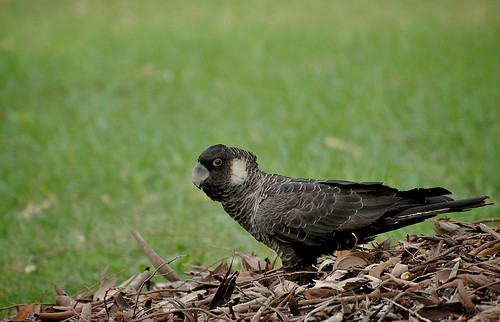 By tracing their movement patterns, feeding and roosting sites along the Swan Coastal Plain, scientists are gaining valuable insights for conservation planning. Image: HelenTHE Department of Environment and Conservation and wildlife volunteers have gained valuable insights into the movement of recently released Carnaby’s Black Cockatoos with satellite tracking devices.
By tracing their movement patterns, feeding and roosting sites along the Swan Coastal Plain, scientists are gaining valuable insights for conservation planning. Image: HelenTHE Department of Environment and Conservation and wildlife volunteers have gained valuable insights into the movement of recently released Carnaby’s Black Cockatoos with satellite tracking devices.
The birds have also been marked with non-toxic blue or pink paint to visually assist with ongoing research undertaken by University of Western Australia’s PhD student Christine Groom.
“The more we learn about the distribution of this endangered species, the better informed we will be to help manage their recovery,” says the Minister for Environment, Mr Marmion.
By tracing their movement patterns, feeding and roosting sites along the Swan Coastal Plain, scientists are gaining valuable insights for conservation planning.
Ms Groom curates a blog reporting the cockatoos’ movements and is seeking the aid of local people to record sightings.
Tracking data revealed released cockatoos quickly joined wild flocks after their release at Perry Lakes and Yanchep National Park.
One bird has already been tracked 100km from the release site.
Two ‘pink tails’ are around Yanchep visiting pine plantations north of Perth.
Another pair headed to Perth Hills where they remain.
“Previously unknown roost sites and daily movement patterns have been recorded with one bird travelling sixty kilometres in one day!” says Ms Groom.
Endemic to the south-west of Western Australia Carnaby’s once filled Perth skies in their thousands.
DEC reported a fifty per cent decline in numbers and breeding sites since the 1970s.
Destruction of habitat and foraging food sources, extreme weather conditions, disease, poachers, poison, shootings, road kills and competition from other species all threaten cockatoos’ existence.
In non-breeding seasons Carnaby’s favour coastal areas—moving inland to breed in old growth woodland.
Large, deep wooden hollow nests are integral to their survival.
Recent documentary ‘On a Wing and a Prayer’ showed this as the chick stayed protected in its deep nest for several weeks before fledging.
DEC’s Carnaby’s recovery plan includes constructing artificial hollows, revegetating native heath/woodlands, planting exotic pines (source food) and promoting community involvement.
Kaarakin Black Cockatoo Rehabilitation Centre and Native Animal Rescue contributed significantly to rehabilitating and releasing the cockatoos.
Researchers hope knowledge of movement corridors in the urban landscape will assist in management plans and secure survival of the species.
To report a sighting of a tail-marked cockatoo or follow their progress: Christine.groom@dec.wa.gov.au